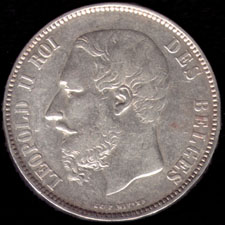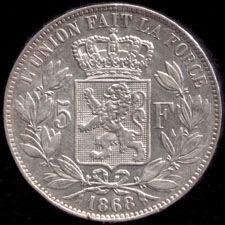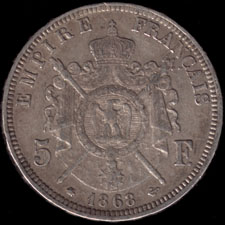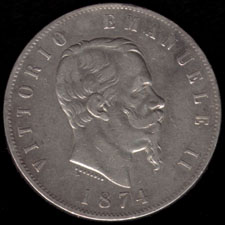Latin Monetary Union
|
|
| Coins | |
|---|---|
| front | back |

| 
|
| George I of Greece 5 drachmae 1874 | |

| 
|
| Leopold II of Belgium 5 francs 1868 | |
| Missing image 5francnapoleoniii1868front.jpg Image:5francnapoleoniii1868front.jpg | 
|
| Napoleon III of France 5 francs 1868 | |

| Missing image 5lirevittorioemanueleii1874back.jpg Image:5lirevittorioemanueleii1874back.jpg |
| Victor Emmanuel II of Italy 5 lire 1874 | |
The Latin Monetary Union was a 19th century attempt to unify several European currencies into a single currency that could be used in all the member states, at a time when most national currencies were still made out of gold and silver.
In 1865, France, Belgium, Italy, and Switzerland (from 1868 Greece and from 1889 Romania, also Austria, Bulgaria, Venezuela, Serbia, Montenegro, San Marino and the Papal State joined the union) agreed to change their national currencies to a standard of 4.5 grams of silver or 0.290322 grams of gold (a ratio of 15.5 to 1) and make them freely interchangeable.
Due to the fluctuations of gold and silver, the union, disrupted by World War I, lasted until 1927 when it was disbanded.
An interesting parallel can be seen between the discussions in the United Kingdom concerning the possibility of the UK joining the Latin Monetary Union [1] (http://www.oup.co.uk/pdf/0-19-924366-2.pdf), and the current discussions concerning UK membership of the euro.
The United States considered joining the Latin Monetary Union, going so far as to have the United States Mint produce pattern coins called Stellas in 1879 and 1880 that would be worth 4 U.S. dollars or 20 French francs. Under this proposal, the US dollar would've been redefined as 22.5 grams of silver (down from 24.06 grams, i.e., 93.52 "old cents")
it:Unione Monetaria Latina de:Lateinische Münzunion fr:Union monétaire latine
